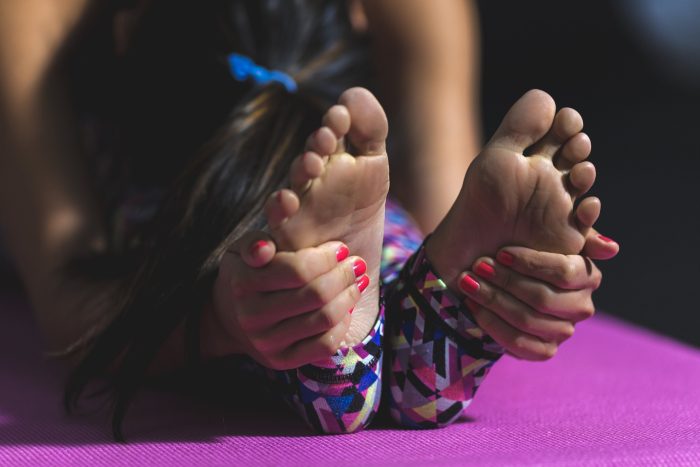Everything I ever needed is inside yoga.
Not everyone should do it, but I recommend it to anyone—to take a piece of it home today.
While that seems contradictory, the breadth of yoga encompasses everything and so there is room for everyone. It’s just that yoga has been under a lot of scrutiny these days.
Perhaps the misconceptions that spark debates about yoga, including the famous Broadwell book on how yoga physically wrecks bodies, has to do with the yoga-light impression that popularization of the practice in recent decades has created: yoga as pop culture, yoga squeezed into exercise packages to reproduce in gym environments, yoga as mystic crystalline smokey chanting and the latest “vilification” as religion by those who reject without understanding.
While yes, there are religious underpinnings, Hindu practices and philosophies inscribed in revered texts, yoga is more and less than religion just as it is more and less than a philosophical treatise or exercise routine. Yoga poses without the proper mindset cultivated over time are nothing more than exercises, potentially painful and often breeding grounds for injury.
I am no expert and do not claim to know more than my experience. For me, and I suspect to many others, Yoga is travel without a destination.
The evolution and expansion of a body, mind and spirit pave the way for the benefits of yoga—a way of life.
The mystery of this unknown yoga first captivated me at 15. I had a pocket manual of black and white photos, small squares of legs, bending torsos and outstretched arms of a skinny woman in saggy leotard and tights. Names of poses in series sparked my imagination: sun salutations, downward dog or cobra. But the mere mimicry of pictures emptied the practice of a quality I later learned about yoga: its unfolding, spreading honeyed shanti over my days, not only after a session but over years.
And even as yoga later hurt me badly—when I hurt myself—it taught me how to heal too.
As a young college student, I took a yoga class where I and the rest of the class learned to relax our bodies. The instructor ended each class with a visualization geared toward novices and re-initiates like myself that entailed talking us, prone pastiche of mats on a gymnasium floor like a quilt, through a deliberate tensing and relaxing of each body part.
The result: a total melting into the mat for a silent, eyes closed focused breathing into the misty calm.
I would later understand that as corpse pose. I experienced it then as healing death, an endless stillness.
Unconsciously, I craved stillness. So several years after this class, a graduate by then, yoga lured me back in. I never stuck with the practice, dedicated in my twenties to the no-pain-no-gain definition of strength by physical and mental torture. To learn tennis, run marathons and play soccer, it took hours of grueling sweat, muscle punishment and residual soreness (the good kind, I would always say) that made me feel alive, the reminder being the pain. I was strong and strong minded, but not strong enough for yoga.
To be yoga strong, we must surrender the urge to create, carve, and craft something to our will in order to belong to something larger than ourselves, something located in quietude. Yoga did eventually teach me that strength—the kind that does not fade with the power and prowess of youth—but not before inflicting a sacrificial wound to awaken me.
During those tempestuous 20s, I took another yoga class, hugely populated, at the local recreation center. The instructor, for what I could see of her at a distance, was a soft spoken white haired woman with the strikingly incongruent name of Pavi for her American mid-west accent and apparel. She led the class without touching anyone, microphone in hand. One day she instructed the class to do a wheel pose.
Looking around, my wheel was flat at the top, not round. So I pushed—no pain-gain style—my inverted middle to the sky when I heard the pop. Or maybe just felt it. I thought the entire class could hear it. Even worse than the sound was the inability to reverse the wheel. Hugging my knees into my head did not undo the damage, only increased the pain.
Pain haunted me for the following six months like a dreadful mistake that dents a life forever. Frenetic patches of orthopedics, physical therapy, chiropractics and acupuncture afforded relief and eventual repair, while yoga kept its distance for the next 20 years. Nothing hurt me like yoga, not even the torn ligaments in my left knee from a snowboarding accident nor the two child births, one lasting 36 hours, that came later.
Yoga betrayed me—or I, it. Where had shanti gone, the bliss of corpse pose on the gymnasium floor? I blamed yoga, the teacher, the class and the recreation center that offered it. Those six months did not feel like peace. I was scarred (with ignorance).
Not until age 49 when yoga whispered, not called, through a friend and yogi, did I return. Broken and beaten by all I believed physically improved me along with lots of lived life, I was ready to listen to my body, respect her to guide me in yoga rather than merely “doing” yoga poses.
Asana practice this time around spoke of steady persistence and calm strength through flexibility achieved in a mind-body cooperative formed over years. It finally sunk in that the body aligns itself not to the pace of the mind but the inverse: yoga leads the mind to and through the body.
My injuries resulted from a mind that imposed its will on an unprepared body. I was blind and deaf to it, so busy beating it into submission. However, in reality, enfolding into the peace of yoga occurs in a harmony of mind and body that together capaciously create and fill those larger components: spirit and disposition.
At first, the body teaches the mind to open through mimicry: just as the body becomes more flexible in time incrementally, so does the mind. But only with patient discipline to restrain competitive (with self or others) impulses. Understanding the nature of yoga–an appreciation of time, patience and listening—disciplines the mind through repetition and restraint in order to unfold.
Meditation, for instance (the aim of yoga). The hushed mind comes after many attempts at merely sitting still and listening to breath. The yoga body already knows that stillness by pure physiological reactions to breathing and movement again and again.
The yoga body’s lessons must be heard, witnessed—especially for us who understand only the language of neurons and the tongue of exhausted surrender physically first before we can hear the pulsing of our heart, the rhythm of our breath and finally, the silence of our minds.
And the mind does follow, kicking and screaming sometimes, knee jittery dashing at other times.
When yoga reached inside me from the outside and touched my mind by the shoulder beckoning it to walk side by side with a body to achieve peace, a clearing spread throughout my bones, sinews, and crevices where impatience pooled and judgment seeped continuously.
The mead of yoga is disposing a body to be mindful. A way of life. Becoming flexible in body meant becoming flexible in my views, increasing my range of understanding about people. Good teachers helped me with kind palms to my back and gentle words at the opening and closing of class.
Harmonizing what I previously understood as a binary—body and mind—brought that flexibility from body to mind to the world. The clearing blankness of my mind each day became quickly filled with possibilities of understanding others. Being kind and respectful to my body led me to practice the same to others.
The yoga path begins in muscle and travels deeper to more enduring spaces. With pacing and respect first of self—not ego—comes the realization that self is part of a whole, of others. The practice engenders compassion and non-judgment for what a body can and cannot do and that self-love is an achievement that emanates into the world.
I did not make yoga heal me of pain or sadness or misconceptions about my connection to others. It happened. When yoga was ready to receive me–when I surrendered.
The life of yoga is larger than us. Yoga cannot be pegged in a hole for it lacks shape. It is not mystical, magical, physical, mental or philosophical. It is yoga—a disposition, an ongoing arrival, where I live now.
Whether we read the Namas and Niyamas, or simply respire the sweet peace of yoga, a piece of its fabric is there for the taking no matter where we are. So long as we know who we are, we know the paradox of parameters—how far we can bend, endure—though physical limits are temporary.
With time we open up, expand, as does our capacity for compassion—like outstretched arms flexible at the sockets to widen and lengthen, embracing all space and time high and low.
What is yoga? Everyone.
Author: Pamela Gerber












Read 1 comment and reply